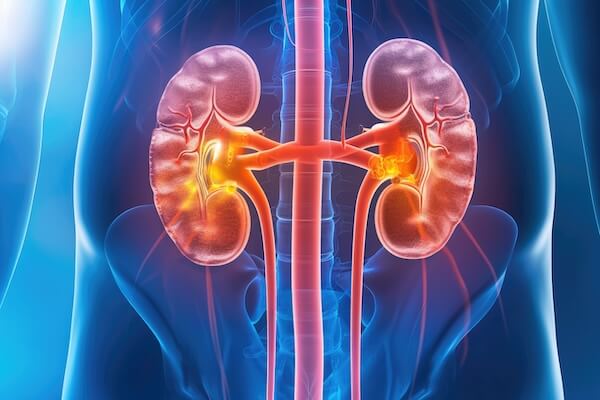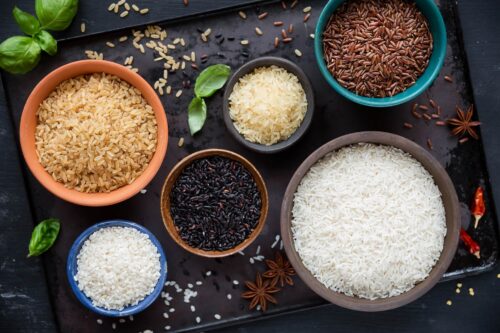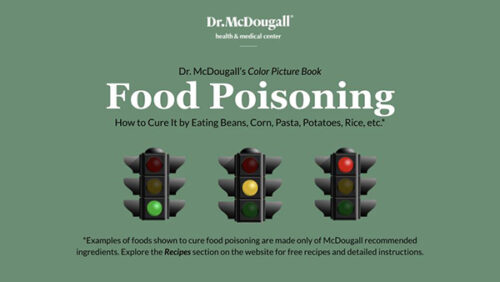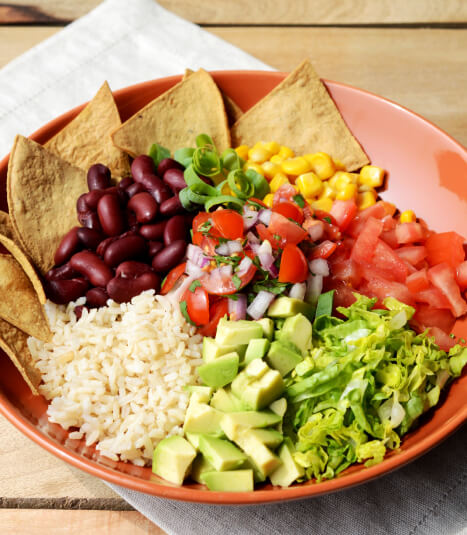Diet and Kidney Health

Typically a patient discovers his or her kidneys are failing by a routine laboratory blood test called a serum creatinine, which indirectly measures kidney function. (Normal creatinine depends on a person’s age and in older adults is 1.2 mg/dL or less.) Once a problem is discovered, the doctor will try to slow the progression of this disease with medications intended to treat high blood pressure, diabetes, high cholesterol, and/or the use of anti-angiotensin medications (as discussed in my June 2007 newsletter). Little or no attention is given to what the patient eats, because primary and ongoing medical training never covers profit-free diet therapy.
Diet becomes a topic for discussion only after the kidneys have been almost completely lost, a condition called end-stage kidney disease—a stage of pre-dialysis. Now the powerful kidney-saving benefits from a healthy diet are of very limited value. At this time a referral is made to a kidney specialist, a nephrologist, and a renal dietitian. They will mention a low protein diet. But, because most of these professionals do not believe patients will follow such a diet, and because they themselves do not have real training and experience with this simple approach, no meaningful change is accomplished. After this cursory discussion of diet, the very sick patient is shuffled off on a tour of the dialysis ward—where he will soon be attached to machines for several hours a day, three or more days a week (at an annual cost of $50,000 to $75,000 per patient; most paid by taxpayers in the USA).
Lack of financial incentives is the reason for no meaningful diet therapy training for your doctors. However, patients with failing kidneys would be very interested in a low-protein diet that would reduce the progression of their kidney disease and death on average by 33% to 50%. In many cases this is a diet that will keep them from ever having to be on dialysis. Moreover, this same diet will improve their overall health and feelings of well-being, eliminating uremic symptoms. The multiple medications that are being used by patients with kidney disease for high blood pressure, diabetes and kidney disease can also be reduced and eliminated by adopting this sensible diet.
Uremia is a condition resulting from advanced stages of kidney failure in which urea and other wastes build up in the body. Early signs of uremia are lethargy, mental depression, loss of appetite, and edema; later, diarrhea, anemia, convulsions, and coma.
The Kidneys
Your two kidneys are located in both sides of your posterior abdomen below the rib cage. These sophisticated processing machines filter 200 quarts of your blood daily and remove on average 2 quarts of waste products and extra water. The rate of filtration is reported as a glomerular filtration rate (GFR), which is calculated from the blood (serum) creatinine level using the patient’s age, weight, gender, and body size. The actual filtering occurs within millions of tiny units inside the kidneys called nephrons. The waste from the breakdown of body tissues and from food, and extra water, becomes urine. Dietary protein is the most common waste (other than water) removed by the kidneys. The kidneys have many other functions including acid-base and fluid balancing, hormone production, and regulation of blood pressure.
Diet Therapy
In his milestone treatise in 1946, Thomas Addis argued from personal clinical experience that reduction in renal work” by judicious dietary protein restriction was effective in minimizing further loss of kidney function in patients with chronic kidney insufficiency from a variety of causes. Thus, for the past sixty years doctors and patients should have known that the primary focus of attention for the preservation of the kidneys should be diet.
The kidneys filter and eliminate most of the nutrients that we do not use, as well as many non-nutrients. (The liver, skin and lungs are also organs that eliminate waste.) Dietary excesses, protein being the primary one, can easily become a burden. (You can actually observe the effects of eating excess protein with the formation of frothy bubbles in the toilet bowl after urinating following a single high protein meal. You (or at least some people) can also smell asparagine, an amino acid, found in high concentration in the protein of the vegetable asparagus when you urinate.)
The human body needs no more than 5% of the calories consumed to be from protein in order to build all cell structures, enzymes and hormones; once these needs are met then the excess must be excreted from the body. The typical Western diet, focused as it is on meat, poultry, eggs, and dairy products, is loaded with protein; as a result, many people consume a diet with 30% or more of the calories from protein.
In the process of eliminating the protein excesses, the blood flow and filtration rates of the kidney tissues (nephrons) increase, which in turn, causes a condition known as intra-glomerular hypertension. Sustained hypertension in the glomeruli leads to progressive damage. This damage is most important and apparent when people have pre-existing kidney loss from conditions such as donation of a kidney, physical injury, diabetes, atherosclerosis, hypertension, and polycystic kidneys. The excess protein accelerates the loss of kidney tissue to the point of end stage kidney disease all too soon in these people.
Even under normal conditions, the burden of excess protein from the typical Western diet overworks the kidneys, causing the loss of kidney tissue. In an otherwise healthy person, 25-50% of his functional kidney capacity will be destroyed after seven to eight decades of eating typical foods. Even so, we have so much reserve tissue that with only 30% of kidney function remaining all of the wastes are still removed; and the damaged and failing kidneys go unnoticed.
The Scientific Research Says Diet Therapy Is Fundamental
Treatment of chronic kidney failure with a low-protein diet is effective in reducing uremic intoxication, slowing the progression of the disease, and preventing secondary hyperparathyroidism. An analysis of multiple studies using a low-protein diet for people with kidney disease has found the measurement of glomerular filtration rate (GFR) decreases by 0.53 mL/min/year less for those on a low protein diet compared with those who follow a usual diet. Furthermore, this analysis found people with diabetic kidney disease received more benefit from diet than those who had kidney disease of other origins. However, people with other forms of kidney disease, including those with polycystic kidney disease have shown remarkable benefits. The amount of protein in the urine (proteinuria), which is considered an important sign of kidney health, is also greatly reduced by this therapy.
Animal vs. Vegetable Protein
The kinds of diets fed to patients vary from those with an emphasis on animal proteins to those of all vegetable proteins (with and without supplementation of essential amino acids and other nutrients). There is substantial evidence that proteins from plants are much healthier for the kidneys and slow the progression of kidney disease more effectively than animal proteins.
For the past twenty years many investigations have focused on the benefits of a vegan diet (no animal foods) for failing kidneys. After studying people on diets of various amounts of vegetable protein one group of researchers concluded, “The vegan diet is associated with glomerular and systemic haemodynamic changes which may be beneficial in the prevention of glomerular sclerotic changes in health and disease.”
In one research project the investigators pointed out that traditional low protein diets were of poor palatability, costly for protein-free substitutes, and hard to follow away from home, resulting in poor compliance. To overcome these drawbacks they used a diet of natural foods of plant origin. Results of the vegan diet were similar to those obtained with the conventional, unpalatable, low-protein diet.
In addition, kidney patients have a very high incidence of developing atherosclerosis, heart disease, and strokes—conditions all accelerated by eating high-fat, high-cholesterol animal foods. Substituting vegetable for animal protein decreases cholesterol which can be expected to translate into better heart health.
Diabetic Kidney Disease and Glomerulonephritis
Two common forms of kidney disease deserve a little more attention. Approximately 40% of people with diabetes severe enough to require insulin will eventually develop kidney damage. In patients with diabetic kidney disease there is a 40-fold difference in the rate of progression of disease. The important and controllable difference is due to the patient’s diet. Once kidney disease begins there is a relentless decline in kidney function and a decline in overall health. The median survival time once kidney disease is established (as seen by the presence of persistent proteinuria) is only 5 to 10 years. These grim statistics can all be changed with a healthy diet and lifestyle.
Chronic glomerulonephritis, also called nephritis, is a disease of the kidneys in which the glomeruli, the tiny filters in the kidneys, become inflamed or damaged. This chronic inflammation will slowly destroy the kidneys unless the cause is removed. An allergic-type of reaction to animal proteins is the most common correctable cause of nephritis. Many children and adults with glomerulonephritis have been cured by changing to a diet of low-allergy vegetable foods.
How to Save the Kidneys
Life without your kidneys, which means you are tied to a dialysis machine, is “hell on earth.” I have found over the years that a tour through the dialysis ward is one good way to motivate people to learn to enjoy a low-protein, starch-based diet, such as the McDougall Diet. That same diet should be vigorously followed to reverse conditions of hypertension, type 2 diabetes and atherosclerosis, all of which, in their own right, lead to kidney damage. Even people who believe they are in good health need to heed this advice.
Evidence of failing kidneys should cause further dietary restrictions; such as the avoidance of high protein vegetable foods, especially the legumes (beans, peas, and lentils). Green and yellow vegetables and mushrooms are also high in protein, but the absolute amount consumed is usually small, so their consequences are few. Fruits and fruit juices are low in protein and can be used more liberally, as plentiful sources of calories. Specially processed low-protein flour products (flours, breads, pastas) can be purchased. (Search the Internet for sources.) The dietary protein intake can be further reduced by adding simple sugars like table sugars, honey and molasses—which are essentially protein-free.
Towards the end of kidney disease caution must be taken to avoid the buildup of potassium in the body, which can be fatal. Fruits and vegetables are high in potassium and contribute to this problem, especially when less than 10% of the kidney function remains. Careful monitoring and changes in diet to include lower potassium fruits and grain products (avoiding green and yellow vegetables and potatoes, for example) will be necessary. Effective dialysis also corrects potassium build-up.
When indicated, medications, such as chlorthalidone, a diuretic, should be used to reduce blood pressure. Most doctors will more aggressively treat high blood pressure than I do when there is evidence of kidney disease (indicated by more than 1 gram of protein in the urine daily). However, reduction of blood pressure below 140/90 mmHg carries risk of an increase of stroke and heart attacks. Anti-angiotensin medications in the form of ACE inhibitors should be used when significant proteinuria is present (See the June 2007 McDougall Newsletter). Diabetics, when necessary, should use insulin, rather than pills, to control blood sugars.
At all stages of kidney health, from perfectly normal to end stage, diet should be a fundamental part of the program. In reality, you are going to have to take the lead in order to incorporate this lifesaving therapy.
References:
1) Maroni BJ, Mitch WE. Role of nutrition in prevention of the progression of renal disease. Annu Rev Nutr. 1997;17:435-55.
2) Remuzzi G, Benigni A, Remuzzi A. Mechanisms of progression and regression of renal lesions of chronic nephropathies and diabetes. J Clin Invest. 2006 Feb;116(2):288-96.
3) Addis T. Glomerular nephritis: diagnosis and treatment. New York: Macmillan, 1948.
4) Brenner B. Dietary protein intake and the progressive nature of kidney disease: The role of hemodynamically mediated glomerular injury in the pathogenesis of progressive glomerular sclerosis in aging, renal ablation and intrinsic renal disease. N Engl J Med 307:652, 1982.
5) Kennedy G. Effects of old age and over-nutrition on the kidney. Br Med Bull 13:67, 1957.
6) Baldwin D. Chronic glomerulonephritis: nonimmunologic mechanisms of progressive glomerular damage. Kidney Int 21:109, 1982.
7) Kasiske BL, Lakatua JD, Ma JZ, Louis TA. A meta-analysis of the effects of dietary protein restriction on the rate of decline in renal function. Am J Kidney Dis. 1998 Jun;31(6):954-61.
8) Gretz N, Meisinger E, Strauch M. Does a low protein diet really slow down the rate of progression of chronic renal failure? Blood Purif. 1989;7(1):33-8
9) Piccoli GB, Motta D, Martina G, Consiglio V, Gai M, Mezza E, Maddalena E, Burdese M, Colla L, Tattoli F, Anania P, Rossetti Low-Protein Vegetarian Diet with Alpha-Chetoanalogues Prior to Pre-emptive Pancreas-Kidney Transplantation. Rev Diabet Stud. 2004 Summer;1(2):95-102.
10) Gentile MG, Fellin G, Cofano F, Delle Fave A, Manna G, Ciceri R, Petrini C, Lavarda F, Pozzi F, D’Amico G. Treatment of proteinuric patients with a vegetarian soy diet and fish oil. Clin Nephrol. 1993 Dec;40(6):315-20.
11) Schiffrin EL, Lipman ML, Mann JF. Chronic kidney disease: effects on the cardiovascular system. Circulation. 2007 Jul 3;116(1):85-97.
12) D’Amico G, Gentile MG. Influence of diet on lipid abnormalities in human renal disease. Am J Kidney Dis. 1993 Jul;22(1):151-7.
13) Bernstein AM, Treyzon L, Li Z. Are high-protein, vegetable-based diets safe for kidney function? A review of the literature. J Am Diet Assoc. 2007 Apr;107(4):644-50.
14) Jibani MM, Bloodworth LL, Foden E, Griffiths KD, Galpin OP. Predominantly vegetarian diet in patients with incipient and early clinical diabetic nephropathy: effects on albumin excretion rate and nutritional status. Diabet Med. 1991 Dec;8(10):949-53.
15) Barsotti G, Morelli E, Cupisti A, Meola M, Dani L, Giovannetti S. A low-nitrogen low-phosphorus Vegan diet for patients with chronic renal failure. Nephron. 1996;74(2):390-4.
16) D’Amico G, Gentile MG, Manna G, Fellin G, Ciceri R, Cofano F, Petrini C, Lavarda F, Perolini S, Porrini M. Effect of vegetarian soy diet on hyperlipidaemia in nephrotic syndrome. Lancet. 1992 May 9;339(8802):1131-4.
17) Barsotti G, Morelli E, Cupisti A, Bertoncini P, Giovannetti S. A special, supplemented ‘vegan’ diet for nephrotic patients. Am J Nephrol. 1991;11(5):380-5.
18) Cupisti A, Morelli E, Meola M, Barsotti M, Barsotti G. Vegetarian diet alternated with conventional low-protein diet for patients with chronic renal failure. J Ren Nutr. 2002 Jan;12(1):32-7.
19) Wiseman MJ, Hunt R, Goodwin A, Gross JL, Keen H, Viberti GC. Dietary composition and renal function in healthy subjects. Nephron. 1987;46(1):37-42.
20) Schiffrin EL, Lipman ML, Mann JF. Chronic kidney disease: effects on the cardiovascular system. Circulation. 2007 Jul 3;116(1):85-97.
21) Spence LA, Lipscomb ER, Cadogan J, Martin B, Wastney ME, Peacock M, Weaver CM. The effect of soy protein and soy isoflavones on calcium metabolism in postmenopausal women: a randomized crossover study. Am J Clin Nutr. 2005 Apr;81(4):916-22.
22) Roughead ZK, Hunt JR, Johnson LK, Badger TM, Lykken GI. Controlled substitution of soy protein for meat protein: effects on calcium retention, bone, and cardiovascular health indices in postmenopausal women. J Clin Endocrinol Metab. 2005 Jan;90(1):181-9.
23) Arjmandi BH, Khalil DA, Smith BJ, Lucas EA, Juma S, Payton ME, Wild RA. Soy protein has a greater effect on bone in postmenopausal women not on hormone replacement therapy, as evidenced by reducing bone resorption and urinary calcium excretion. J Clin Endocrinol Metab. 2003 Mar;88(3):1048-54.
24) Martinez RM, Gimenez I, Lou JM, Mayoral JA, Alda JO. Soy isoflavonoids exhibit in vitro biological activities of loop diuretics. Am J Clin Nutr. 1998 Dec;68(6 Suppl):1354S-1357S.
25) Hansen HP, Christensen PK, Tauber-Lassen E, Klausen A, Jensen BR, Parving HH. Low-protein diet and kidney function in insulin-dependent diabetic patients with diabetic nephropathy. Kidney Int. 1999 Feb;55(2):621-8.
26) Dullaart RP, Beusekamp BJ, Meijer S, van Doormaal JJ, Sluiter WJ. Long-term effects of protein-restricted diet on albuminuria and renal function in IDDM patients without clinical nephropathy and hypertension. Diabetes Care. 1993 Feb;16(2):483-92.
27) Evanoff G, Thompson C, Brown J, Weinman E. Prolonged dietary protein restriction in diabetic nephropathy. Arch Intern Med. 1989 May;149(5):1129-33.
28) Zeller K, Whittaker E, Sullivan L, Raskin P, Jacobson HR. Effect of restricting dietary protein on the progression of renal failure in patients with insulin-dependent diabetes mellitus. N Engl J Med. 1991 Jan 10;324(2):78-84.
29) Genova R, Sanfilippo M, Rossi ME, Vierucci A. Food allergy in steroid-resistant nephrotic syndrome. Lancet. 1987 Jun 6;1(8545):1315-6.
30) Lagrue G, Laurent J, Belghiti D, Sainte-Laudy J. Food sensitivity and idiopathic nephrotic syndrome. Lancet. 1985 Oct 5;2(8458):777.
31) Laurent J, Rostoker G, Robeva R, Bruneau C, Lagrue G. Is adult idiopathic nephrotic syndrome food allergy? Value of oligoantigenic diets. Nephron. 1987;47(1):7-11.
32) Howanietz H, Lubec G. Idiopathic nephrotic syndrome, treated with steroids for five years, found to be allergic reaction to pork. Lancet. 1985 Aug 24;2(8452):450.
33) Sato M, Takayama K, Wakasa M, Koshikawa S. Estimation of circulating immune complexes following oral challenge with cow’s milk in patients with IgA nephropathy. Nephron. 1987;47(1):43-8.
34) Russell MW, Mestecky J, Julian BA, Galla JH. IgA-associated renal diseases: antibodies to environmental antigens in sera and deposition of immunoglobulins and antigens in glomeruli. J Clin Immunol. 1986 Jan;6(1):74-86.
Recommended Articles

How to Cook Beans

How to Cook Rice





